Moving air handlers from attics is a good idea…even better add more attic insulation at the same time…what could go wrong?
The worst thing you could do is install furnaces and air conditioning systems in vented attics – even worse than installing them in vented crawlspaces1. The attics are way hotter than the outside in the summer and cold and miserable in the winter – and in hot humid climates it gets ugly (Photograph 1). You can’t get at them easily to service them. They don’t last very long. They need to be in a better place.
What about putting them in garages? Ahhhh man….in Michigan they call that the Kevorkian option2….they need to be inside….and while you are moving them inside increase attic insulation levels. Should be easy, eh? Nope. There is no such thing as a free thermodynamic lunch….
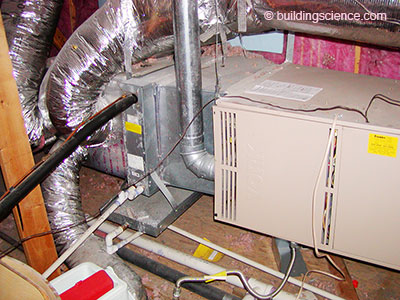
Photograph 1: Air Handler in Attic - The worst thing you could do is install furnaces and air conditioning systems in vented attics. The attics are way hotter than the outside in the summer and cold and miserable in the winter – and in hot humid climates it gets ugly. You can’t get at them easily to service them. They don’t last very long. They need to be in a better place.
Let’s look at this in stages…and in the most difficult climate zone. Most difficult climate zone? Not where you think. Hot humid climates are way more difficult than the rest. It ain’t a picnic building stuff on a sandbar or in a swamp in the middle of the Gulf of Mexico. The view to Cuba is pretty nice from both3 but that is about it if you are in the conditioning business. Give me snow any day – that is easy to deal with by comparison.4
We collectively have beat up the south Texas and south Florida folks pretty well - so much so that they started to take the air handlers out of attics and put them in garages. Trouble was just putting them in the garage was not enough (Photograph 2). There are complications. See Kevorkian above. Also, garages from a temperature and humidity perspective are not that much better than attics. Or are they better? It depends on how you define better.
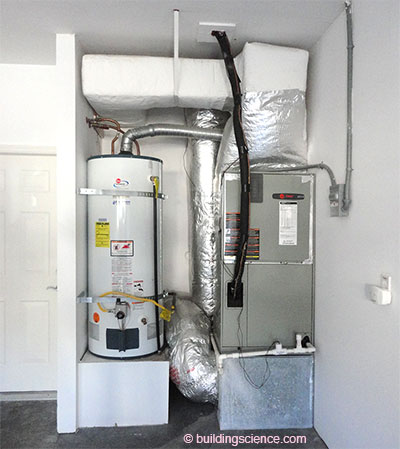
Photograph 2: Air Handler in Garages - There are complications. See Kevorkian. The air in an attic and garage comes from the same place…outside. Same dew point but higher relative humidity. It gets worse…wait for it….in a hot attic the box that makes air cold is actually warmer. Not so much in a garage. Air handlers themselves are colder as are the supply plenums that are attached to them. So stuff sweats more…way more. We actually increased moisture problems with equipment and ductwork when we moved air handlers from attics into garages.
Better usually means cooler. Garages don’t have as much of a thermal load as an attic. Yes, garages are cooler but that is actually "worser".5 Cooler temperatures mean higher relative humidities. The air in an attic and garage comes from the same place…outside. Same dew point but higher relative humidity. It gets worse…wait for it….in a hot attic the box that makes air cold is actually warmer. Not so much in a garage. Air handlers themselves are colder as are the supply plenums that are attached to them. So stuff sweats more…way more. We actually increased moisture problems with equipment and ductwork when we moved air handlers from attics into garages.
Now what? Not going to move them back into the attic. Next approach was put them in a closet in the garage (Photograph 3). Easy peasy right? Not if they are also gas furnaces. And if you have a gas water heater beside them it gets complicated (Photograph 4). You have to provide combustion air – basically a big hole connecting the closet to the garage. Defeats the purpose which was to stop the sweating. Unless the gas furnaces are sealed combustion and the water heaters are sealed combustion. I like sealed combustion stuff (Photograph 5)…but it’s expensive. Did I mention I like sealed combustion?
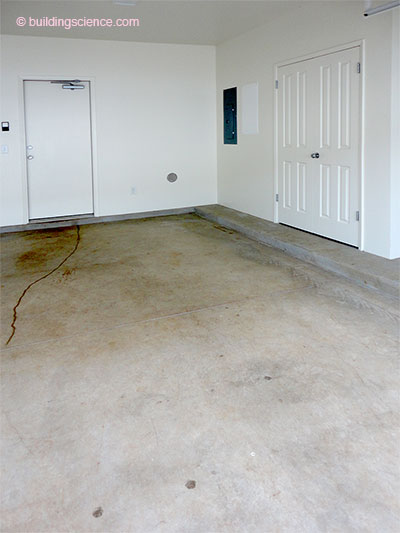
Photograph 3: Air Handler in Closet in Garage - Easy peasy right? Not if they are also gas furnaces. What about combustion air?.
Folks ended up doing a bunch of things so as to avoid the sealed combustion approach. They would leave the gas water heater outside of the closet (Photograph 6) or they would change the gas water heater for an electric water heater. And then get rid of the gas furnace and go with a heat pump. Now the big combustion air hole issue goes away. Weatherstrip the closet door and we are good right? Nope. Ahhh man….now what?
That box that makes air cold is cold and being in a closet makes it even colder. Not only is the box colder but the closet the box is in is also colder. There is almost no load in the closet. Surface temperatures go down and relative humidity adjacent these surfaces go up. Yup, the “M” word. Mold. Cold closet with cold equipment in a garage in south Florida and southeast Texas? Fun eh?
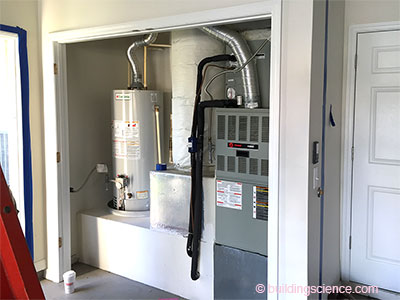
Photograph 4: Gas Water Heater and Gas Furnace In Closet – Standard gas water heaters and gas furnaces need combustion air – basically a big hole connecting the closet to the garage. Defeats the purpose which was to stop the sweating.
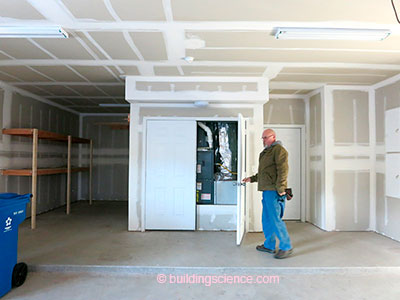
Photograph 5: Sealed Combustion – If the gas furnaces are sealed combustion and the water heaters are sealed combustion then transfer air from the garage is not necessary. Great approach…except…closet gets cold.
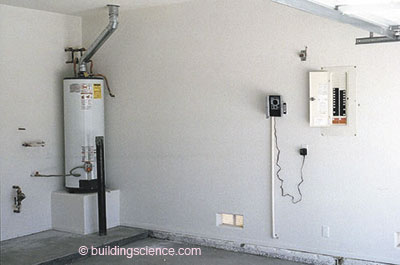
Photograph 6: Lonely Water Heater - Leaving the standard gas water heater outside of the closet solves the combustion air problem for the gas water in the closet as does changing the gas water heater for an electric water heater.
We have to make the closet warmer. Have to heat the closet? Get out of town…. Yup, but we have to be clever about it. Put a return in the closet (Figure 1). Yup. That is insane. Nope. Where does the make-up air come from? Take it from the house. Couple the closet to the house. Use a jump duct (Figure 2) or transfer grille (Figure 3) so that warm air from the house is pulled into the closet warming the closet. This air is also drier than air from the garage – much drier. This works. You have to be careful not to depressurize the closet too much – no more than 2 or 3 Pascal’s6.
How do you size the return and the jump ducts and transfer grilles? You guess and measure and watch. A 6 inch x 6 inch grille on the return plenum and a 12 inch by 16 inch transfer grille to the house works. How do I know? See the measure and watch sentence above. That’s an awfully big hole to the house. Yup. Not easy to make that work with a closet in the garage. Yup. Now what?
Put the air handler inside the house. Where it belongs. It is much easier to make all of this stuff work inside. But now you have to pay attention to two really important things. Two things. Not just one. First, the air handler closet is going to be even colder than when it was in the garage. Second, the moisture levels in the closet are higher at the top of the closet than at the bottom. I will defend this crazy statement later. But for now just go with it.
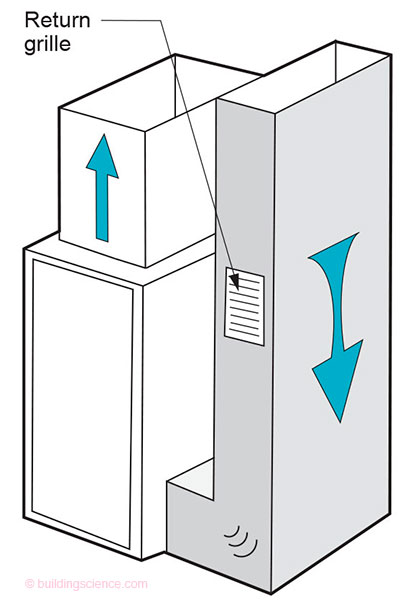
Figure 1: Return-In-Closet - Have to make the closet warmer. Where does the make-up air come from? Take it from the house. Couple the closet to the house.
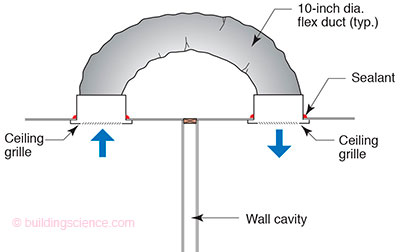
Figure 2: “Jump Duct” – Flex duct providing transfer air from house to closet.

Figure 3: Transfer Grille - Warm air from the house is pulled into the closet warming the closet. Grilles are offset high and low to reduce noise transfer.
If all you do is put the air handler inside the house in a closet inside the house you will get mold. Not a lot. But some. It typically ends up at the ceiling of the closet where the supply plenum penetrates the ceiling (Photograph 7). This problem goes away with a grille on the return plenum (see Figure 1 again) coupled with a jump duct or transfer grille. What about a louvered door? Works, but folks don’t always like the air handler noise.
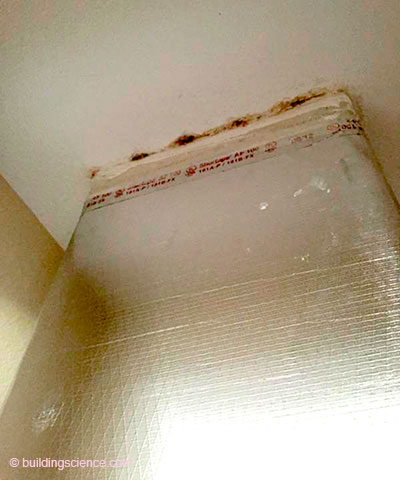
Photograph 7: Mold at Ceiling of Mechanical Closet - If all you do is put the air handler inside the house in a closet inside the house you will get mold. Not a lot. But some. It typically ends up at the ceiling of the closet where the supply plenum penetrates the ceiling. This problem goes away with a grille on the return plenum (see Figure 1 again) coupled with a jump duct or transfer grille.
I know some of you will be shocked at this, but it is quite common to insulate the mechanical closet walls for acoustical purposes – which, yup, you guessed it, makes the closet even colder. The quietest arrangement seems to be a jump duct with acoustically insulated walls. The make-up air from the main part of the house should come into the closet near the ceiling or through the ceiling (see the “second thing” above). You get a warm closet, warm air handler, warm supply plenum surfaces and quiet. Are we done yet? Ah, no.
Couple of important things. The mechanical closet is going to be slightly negative. The ductwork penetrating the ceiling needs to be sealed in an airtight manner if the ceiling is at the underside of a vented attic. You do not want to pull hot humid air down into the mechanical closet from the attic. The supply and return ductwork should not be flex duct (Photograph 8) as it is extremely difficult to seal – go with rigid duct (Photograph 9).
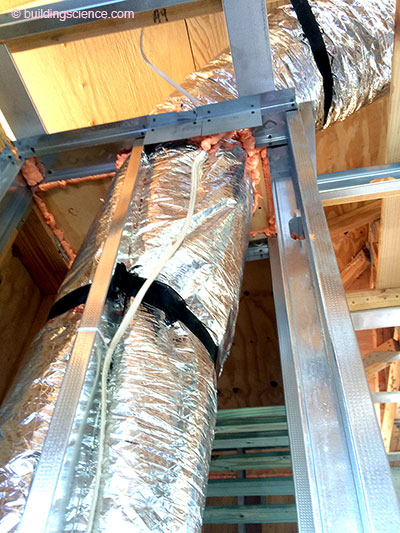
Photograph 8: Flex Duct - The mechanical closet is going to be slightly negative. The ductwork penetrating the ceiling needs to be sealed in an airtight manner if the ceiling is at the underside of a vented attic. You do not want to pull hot humid air down into the mechanical closet from the attic. The supply and return ductwork should not be flex duct as it is extremely difficult to seal.
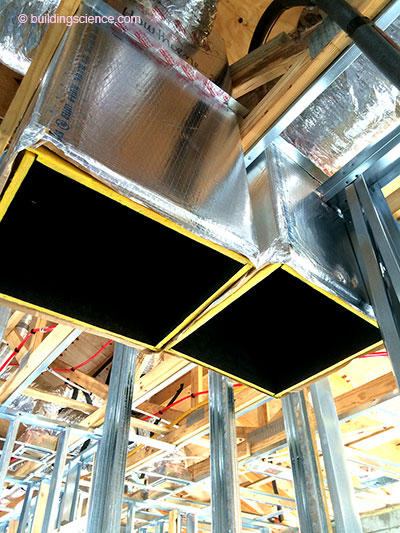
Photograph 9: Rigid Duct - Go with rigid duct as it is much easier to seal where it penetrates ceilings.
Done yet? No. Remember the moisture levels being higher up high thing mentioned earlier? Not supposed to happen according to typical theory. Except it does7.
Boys and girls you can do this experiment at home. First, find a friend who likes you but believes that you are wrong and brings his own dewpoint meter to demonstrate that you are clearly wrong (Photograph 10). Have a camera ready to record for posterity his proof of just how wrong you are (Photograph 11). Oops. Not wrong. Meter must be wrong. Actually, no. We have been recording this in unvented attics for quite some time (check out BA-1511 on the www.buildingscience.com website).
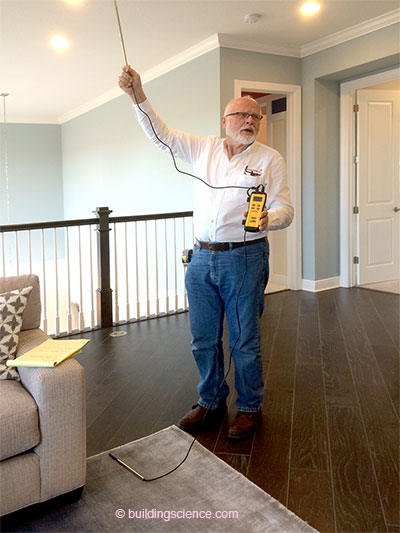
Photograph 10: Friend With Meter - Boys and girls you can do this experiment at home. First, find a friend who likes you but believes that you are wrong and brings his own dewpoint meter to demonstrate that you are clearly wrong. Sensor at floor and near ceiling. Have a camera ready to record for posterity his proof of just how wrong you are (Photograph 11). Oops. Not wrong. Meter must be wrong. Actually, no.
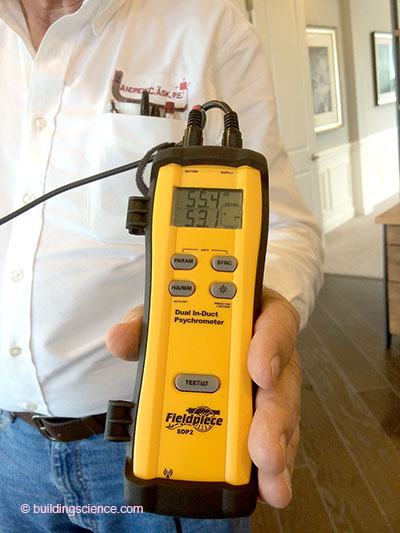
Photograph 11: Meter Reading - Have a camera ready to record for posterity his proof of just how wrong you are. Oops. Not wrong. Meter must be wrong. Actually, no. Difference in dewpoint temperatures between floor and ceiling.
So why should we care? Remember way back when – the beginning of this discussion – when I pointed out that attic insulation levels are also going up? What happens when you increase attic insulation from R-30 to R-38? Wait for it….your ceiling gets colder…. Don’t you just love this? Yup, the attic insulation does its job. The load from the attic is reduced. Couple this with higher dewpoint temperatures at the underside of the ceiling and what do you get? Ah, the M word again. What spaces have the least load? Closets. Closets need “active” returns at the ceilings (Photograph 12) and undercut doors. Closets are now getting colder.
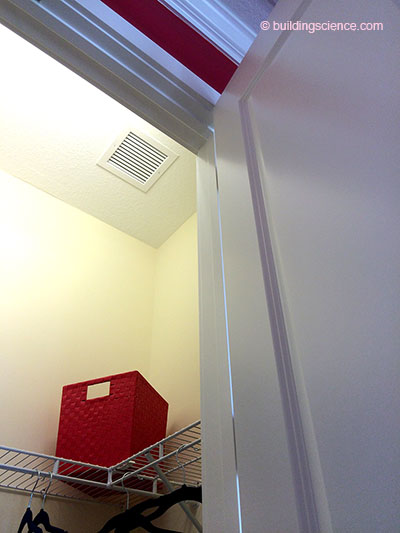
Photograph 12: Closets Need Returns - What spaces have the least load? Closets. Closets need “active” returns at the ceilings and undercut doors. Closets are now getting colder.
No good deed goes unpunished. Yes, move the air handlers inside. Yes, increase attic insulation levels. But you have to compensate for the changes in relative humidity. You think this is fun yet? Wait till you provide high levels of whole house ventilation…and good windows….sounds like the 2015 IECC and ASHRAE Standard 62.2. Probably should invest in a dehumidification company and find yourself a really good HVAC contractor.
Reference
BA-1511: Field Testing of an Unvented Roof with Fibrous Insulation, Tiles, and Vapor Diffusion Venting; www.buildingscience.com; November, 2015
Footnotes:
- This could be an interesting debate over spirits or hoppy fermented liquids….attics are way hotter so if Arrhenius is right they are a more miserable place…. but crawlspaces are way wetter….….but sometimes attics are both hot and wet and cold and wet….I don’t know…crawlspaces see ground water and soil gas and weird living things….
- Air handlers leak air and unlike ductwork which you can actually “seal” with mastic you are not “allowed” to air seal the air handler itself as it voids the warranty. The typical air handler leaks about 50 cfm of air. When this is on the supply side what the heck….supplying air to the garage from the house….not so bad…an energy penalty for sure but not horribly bad…more air change…mostly a problem in humid climates because of the part load humidity thing but not horribly bad. When this is on the return side…..bad….very bad. Just for fun go to your local building department and tell the Chief Building Official that you are going to put a 50 cfm return in garage and watch for the reaction. Then go on line and search Jack Kevorkian. Enjoy the moment.
- Galveston, TX and Miami, FL
- OK, not true, but go with the rant here. Not everything has to be true, it just has to sound good for your argument. Pretend you are a journalist. However, for a serious discussion go check out “BSI-046: Dam Ice Dam”, February 2011.
- Millennialism. Apparently Gen Y gets to ignore rules and make stuff up….I want in on that…today I “feel” that “worser” is a real word and if I feel it…it must be true.
- Where does this number come from? I guessed. I get to do this. I am an engineer. Old school. Don’t like the word “guess”? OK, use the words “experience” and “judgement”. Those latter words are basically “educated guesses” made by old engineers. Feel better now?
- When I wrote about this in “BSI-077: Cool Hand Luke Meets Attics”, July 2015, I got beat up by all kinds of folks. Smart folks. Friends. Told me stuff like “you clearly do not understand diffusion theory” and “The Second Law of Thermodynamics does not allow this… Except observation, measurement and experiment shows that it happens. What’s a guy supposed to believe? Theory or observation? If you have trouble with the answer to this question see Feynman – the bongo playing physicist – my generations Einstein, Newton and Galileo. Guess we need a better theory or a better application of the existing theory. If someone emails me a computer simulation trying to prove me wrong I will find them and hurt them.
